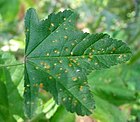Note: This is a project under development. The articles on this wiki are just being initiated and broadly incomplete. You can Help creating new pages.
Difference between revisions of "Malva sylvestris"
| Line 11: | Line 11: | ||
==Chemical Composition== | ==Chemical Composition== | ||
| − | + | M. sylvestris contains malvin and malonylmalvin.[22] It also contains the naphthoquinone malvone A, which is also a phytoalaxin.<ref name="chemical composition"/> | |
==Common names== | ==Common names== | ||
| − | {{Common names|kn=|ml=|sa=|ta=|te=|hi=|en= | + | {{Common names|kn=|ml=|sa=|ta=|te=|hi=|en=Wood mallow, Tree mallow, High mallow}} |
==Properties== | ==Properties== | ||
| Line 33: | Line 33: | ||
==Habit== | ==Habit== | ||
| − | {{Habit| | + | {{Habit|Herbs}} |
==Identification== | ==Identification== | ||
===Leaf=== | ===Leaf=== | ||
| − | {{Leaf|Simple| | + | {{Leaf|Simple|Roundish|The leaves are borne upon the stem, with numerous lobes, each 2–4 centimetres (0.79–1.57 in) long, 2–5 centimetres (0.79–1.97 in) and 5–10 centimetres (2.0–3.9 in) in diameter.The leaves have hairs radiating from a common center, with prominent veins on the underside.}}<ref name="Leaf"/> |
===Flower=== | ===Flower=== | ||
| − | {{Flower|Unisexual|1 | + | {{Flower|Unisexual|2–3 millimeters long and 1.5 millimeters wide|reddish-purple, bright pinkish-purple with dark stripes and bright mauve-purple|2-4|Its calyx is free to the middle, 3–6 millimeters long, with broadly triangular lobes or ovate mostly 5–7 millimeters long. The flowers are 2–4 times as long as the calyx}} |
| − | |||
| − | |||
| − | |||
===Other features=== | ===Other features=== | ||
| Line 54: | Line 51: | ||
==How to plant/cultivate== | ==How to plant/cultivate== | ||
| + | It is often grown as an ornamental plant for its attractive flowers, produced for a long period through the summer. Numerous cultivars have been selected and named. | ||
<ref name="How to plant/cultivate"/> | <ref name="How to plant/cultivate"/> | ||
| Line 61: | Line 59: | ||
==Photo Gallery== | ==Photo Gallery== | ||
<gallery class="left" caption="" widths="140px" heights="140px"> | <gallery class="left" caption="" widths="140px" heights="140px"> | ||
| − | + | File:Wilde Malve Malva sylvestris 0530.jpg | |
| + | File:Malva sylvestris hoja enferma.jpg | ||
| + | File:Malva sylvestris - Köhler–s Medizinal-Pflanzen-222.jpg | ||
</gallery> | </gallery> | ||
| Line 67: | Line 67: | ||
<references> | <references> | ||
| − | <ref name="chemical composition">[ | + | <ref name="chemical composition">[https://linkinghub.elsevier.com/retrieve/pii/S003194220600478X Chemical composition]</ref> |
| − | <ref name="Leaf">[ | + | <ref name="Leaf">[http://www.botanical.com/botanical/mgmh/m/mallow07.html#blu Plant description]</ref> |
| − | <ref name="How to plant/cultivate">[ | + | <ref name="How to plant/cultivate">[http://www.perennials.com/plants/malva-sylvestris-zebrina.html Cultivation Details]</ref> |
</references> | </references> | ||
==External Links== | ==External Links== | ||
| − | * [ Malva sylvestris] | + | * [https://commons.wikimedia.org/wiki/Category:Malva_sylvestris Malva sylvestris] |
[[Category:Herbs]] | [[Category:Herbs]] | ||
Revision as of 15:03, 2 June 2020
Malva sylvestris is a species of the mallow genus Malva in the family of Malvaceae and is considered to be the type species for the genus.
Contents
- 1 Uses
- 2 Parts Used
- 3 Chemical Composition
- 4 Common names
- 5 Properties
- 6 Habit
- 7 Identification
- 8 List of Ayurvedic medicine in which the herb is used
- 9 Where to get the saplings
- 10 Mode of Propagation
- 11 How to plant/cultivate
- 12 Commonly seen growing in areas
- 13 Photo Gallery
- 14 References
- 15 External Links
Uses
Asthma, Bronchitis, Coughing, Throat infections, Emphysema.
Parts Used
Chemical Composition
M. sylvestris contains malvin and malonylmalvin.[22] It also contains the naphthoquinone malvone A, which is also a phytoalaxin.[1]
Common names
| Language | Common name |
|---|---|
| Kannada | |
| Hindi | |
| Malayalam | |
| Tamil | |
| Telugu | |
| Marathi | NA |
| Gujarathi | NA |
| Punjabi | NA |
| Kashmiri | NA |
| Sanskrit | |
| English | Wood mallow, Tree mallow, High mallow |
Properties
Reference: Dravya - Substance, Rasa - Taste, Guna - Qualities, Veerya - Potency, Vipaka - Post-digesion effect, Karma - Pharmacological activity, Prabhava - Therepeutics.
Dravya
Rasa
Guna
Veerya
Vipaka
Karma
Prabhava
Habit
Identification
Leaf
| Kind | Shape | Feature |
|---|---|---|
| Simple | Roundish | The leaves are borne upon the stem, with numerous lobes, each 2–4 centimetres (0.79–1.57 in) long, 2–5 centimetres (0.79–1.97 in) and 5–10 centimetres (2.0–3.9 in) in diameter.The leaves have hairs radiating from a common center, with prominent veins on the underside. |
Flower
| Type | Size | Color and composition | Stamen | More information |
|---|---|---|---|---|
| Unisexual | 2–3 millimeters long and 1.5 millimeters wide | reddish-purple, bright pinkish-purple with dark stripes and bright mauve-purple | 2-4 | Its calyx is free to the middle, 3–6 millimeters long, with broadly triangular lobes or ovate mostly 5–7 millimeters long. The flowers are 2–4 times as long as the calyx |
Other features
List of Ayurvedic medicine in which the herb is used
Where to get the saplings
Mode of Propagation
How to plant/cultivate
It is often grown as an ornamental plant for its attractive flowers, produced for a long period through the summer. Numerous cultivars have been selected and named. [3]
Commonly seen growing in areas
Photo Gallery
References
External Links
- Ayurvedic Herbs known to be helpful to treat Asthma
- Ayurvedic Herbs known to be helpful to treat Bronchitis
- Ayurvedic Herbs known to be helpful to treat Coughing
- Ayurvedic Herbs known to be helpful to treat Throat infections
- Ayurvedic Herbs known to be helpful to treat Emphysema
- Herbs with Leaves used in medicine
- Herbs with Flower used in medicine
- Herbs with common name in English
- Habit - Herbs
- Index of Plants which can be propagated by Seeds
- Herbs that are commonly seen in the region of Subtropical area
- Herbs



